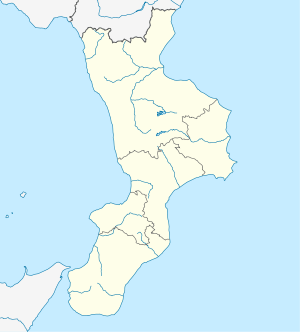Scalea
Scalea (Calabrian: Scalìa) is a town and comune in the province of Cosenza in the Calabria region of southern Italy.
Scalea | |
|---|---|
| Comune di Scalea | |
.jpg) | |
 Coat of arms | |
Location of Scalea 
| |
 Scalea Location of Scalea in Italy  Scalea Scalea (Calabria) | |
| Coordinates: 39°49′N 15°48′E | |
| Country | Italy |
| Region | Calabria |
| Province | Cosenza (CS) |
| Government | |
| • Mayor | Gennaro Licursi |
| Area | |
| • Total | 22 km2 (8 sq mi) |
| Elevation | 25 m (82 ft) |
| Population (2007)[2] | |
| • Total | 10,429 |
| • Density | 470/km2 (1,200/sq mi) |
| Demonym(s) | Scaleoti |
| Time zone | UTC+1 (CET) |
| • Summer (DST) | UTC+2 (CEST) |
| Postal code | 87029 |
| Dialing code | 0985 |
| Patron saint | Holy Virgin of Mount Carmel |
| Saint day | July 16 |
| Website | Official website |
The town takes its name from its terraced lay-out on the hillside, at the bottom of the Capo Scalea promontory. The old town is placed on the heights and preserves the remains of an ancient wall, while towards the beach, the Scalea Marina centre has recently been developed, with modern hotels, villas and numerous bathing areas on the beach.
Etymology
Scalea probably derives from Scala which currently only means "ladder" in Italian, but used to also refer to any "[exclusively] commercial harbor", initially on a derogatory sense, as the military ports were never as disorganized as the commercial ones with the makeshift ladders and planks, instead of sturdy docks and built quays.
History
Scalea was inhabited since prehistorical times, as proved by the material of the Paleolithic period that was excavated in a cavern near Torre Talao, which dominates over the rocky promontory called Scalea Island. It is claimed that the town of Laüs, of pre-Indo-European origin and colonized by the Sybarites in the 6th-5th century BC, once stood on the plain South of Scalea, near the mouth of the river Lao.
Main sights
- Palazzo dei Principi (13th century)
- Palazzetto Normanno (12th century)
- Church of San Nicola in Plateis (originally from the 8th century, later restored).
- Torre Talao, a tower built in the 16th century, part of a system of 337 coastal towers built to deter the pirate attacks.
| Wikimedia Commons has media related to Scalea. |
References
- "Superficie di Comuni Province e Regioni italiane al 9 ottobre 2011". Istat. Retrieved 16 March 2019.
- "Popolazione Residente al 1° Gennaio 2018". Istat. Retrieved 16 March 2019.